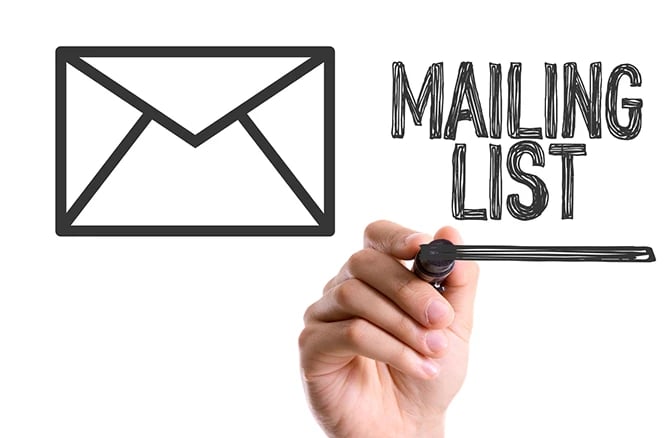We Are Here to Help!
What to Expect from Us:
No Pressure, Just Service!
Get no obligation pricing details and strategies that will work for your business.
In direct-mail marketing, success hinges not just on the design of your postcard but on a strategic approach. A crucial element that plays a significant role in your success is the direct mailing list and selecting the right mailing list service.
Concentrating on your direct mailing lists while optimizing your printing and mailing expenses is vital to connecting with the desired audience and achieving a high ROI on your direct mail campaign. Doing so will set the stage for a well-executed marketing campaign that effectively reaches your target market. This guide outlines the steps marketers and business owners can take to create and maintain effective direct mailing lists.
Understanding Mailing Lists
A mailing list comprises the names, physical addresses, and other contact details of your clients and potential customers, the basic information required for a mailing service. Nowadays, mailing list selection criteria include customer demographics, lifestyle, and shopping behaviors, which allows for a comprehensive understanding of your target audience for your products and services. Utilizing this data enables you to tailor your mailing list to the best prospects for the products/services your business offers.
Why You Need a Mailing List
As a cornerstone of successful marketing strategies, a mailing list serves as a direct channel to your audience, offering unparalleled opportunities for engagement and conversion. The importance of the mailing list is further highlighted by Ed Mayer's 40/40/20 rule, which underscores the need for a balanced approach in marketing endeavors.
According to Mayer, an effective campaign should allocate 40% of its focus on reaching the right audience, another 40% on crafting an offer that is simply too good to resist, and the remaining 20% on creative aspects such as design and presentation. This well-rounded strategy exemplifies why a direct mail marketing list is not just an asset, but a necessity for businesses aiming to make a significant impact in their direct marketing efforts.
Having a mailing list of ideal prospects for your business allows you to:
- Reach a specific audience likely to be interested in your product or service
- Customize messaging that resonates with different segments
- Maximize the effectiveness of your campaigns
- Save money by targeting individuals who meet your customer profile

Different Kinds of Direct Mailing Lists
Lists offered by mailing service providers come in various forms, each with its unique characteristics and advantages. Understanding the variations is essential for a list owner to craft an effective and targeted mailing list. Let's explore the different types of direct marketing lists available and the strategic opportunities they present to businesses seeking to make a lasting impact on their audience.
Remember to carefully choose the type of mailing list that aligns with your marketing goals and target audience. Proper planning and selection will help you achieve successful results and maximize the effectiveness of your next direct mail campaign. Here are the main types of direct mail lists:
Lists from Subscriptions
Specialty lists from subscriptions encompass individuals who have expressed a level of interest in specific topics or industries, and they can be a valuable asset for marketers seeking to connect with an engaged audience.
Subscribers to publications, whether they are physical magazines or digital newsletters through an email list, and customers of recurring services have already demonstrated an interest in a particular subject matter or industry. By understanding the topics or services they have subscribed to, you can tailor your direct marketing messages to resonate with their specific interests. This inherent alignment makes them a highly targeted audience that will likely lead to a higher response rate.
Here are some examples of subscription lists that can be used for direct mail marketing:
- Health Sector: Marketers can utilize lists from health and wellness publications to target fitness equipment buyers, supplement users, and wellness service seekers with tailored offers.
- Financial Services: Subscription lists from financial newsletters are perfect for targeting with offers on investment opportunities, financial advice, and banking products, catering to those interested in personal finance and investing.
- Technology Industry: Tech companies can target subscribers of tech and gadget publications with the latest electronics, software, and tech services, matching their interest in cutting-edge technology.
- Travel Agencies and Hospitality: Travel and leisure magazine subscribers are prime targets for vacation packages, travel deals, and destination tips, appealing to their love for adventure and exploration.
- Food and Culinary Products: Those subscribed to food publications can be targeted by kitchenware retailers, gourmet food brands, and cooking schools with products, classes, and recipes suited to culinary enthusiasts.
- Fashion and Lifestyle: Fashion magazine lists allow retailers and beauty brands to offer the latest fashion and beauty products to style-conscious individuals.
- Professional Services: Lists from industry-specific newsletters (e.g., legal, medical, educational) enable targeting professionals with relevant services, products, and continuing education opportunities.
Lists from Events
Gatherings of like-minded individuals provide a fertile ground for collecting up-to-date contact information and gaining insights into the psychographics of prospective buyers, particularly in the B2B (business-to-business) sector.
Events draw attendees who are actively engaged and interested in the industry or topic at hand. As a result, many event holders and organizers make the list of attendees available for sale to marketers looking to use the list for their direct mail campaigns. These direct mail lists can provide a highly targeted audience for your mailing that may not be available from other mailing list sources.
Here are examples of conference and trade shows whose attendee list can be used as a targeted direct mailing list:
- Tech Conferences: Ideal for promoting software, gadgets, or IT services through direct mail to attendees interested in technological advancements.
- Trade Shows: Useful for businesses across manufacturing, automotive, or fashion to send catalogs, product updates, or demo invitations.
- Professional Events: Perfect for service-oriented firms (legal, financial, consulting) to distribute newsletters, white papers, or consultancy offers.
- Healthcare Conferences: For companies in pharmaceuticals, medical equipment, or health services to share information on new drugs, devices, or programs.
- Educational Seminars: Enables educational institutions and ed-tech companies to promote courses, training, or educational resources.
- Real Estate Expos: Allows real estate agencies and developers to mail brochures, property listings, and open house invitations.
- Travel Fairs: Ideal for the hospitality and travel industry to offer holiday packages, hotel promotions, or travel guides.
- Dental Conferences: Dental practices and suppliers use these lists to promote dental products, procedures, and educational courses to professionals in the field.
Mailing Lists Based on First-Party Data
These are mailing lists your business has developed on its own, using first-party or in-house data. A home-grown consumer mailing list results from your business's diligent efforts in gathering and harnessing data from customer interactions and engagements.
Gathered through various touchpoints like website interactions, in-store purchases, loyalty programs, and customer surveys, your business accumulates a wealth of information, including demographic details, contact information, past purchase history, and even behavioral patterns.
This approach allows you to identify your audience's demographic profile and better understand their preferences for your future direct mail marketing campaign.
In-house mailing lists provide some of the highest direct mail response rates as the people on the lists have often already interacted with and have been willing to share their personal information with your business.

Lists Based on Second-Party Data
Mailing lists based on second-party data or response lists are compiled lists of individuals or businesses created through a partnership or collaboration with another company or organization with products or services similar to yours. These lists are generated by leveraging data collected by a trusted partner and can be used for targeted marketing purposes.
These targeted mailing lists are valuable in marketing because they consist of people or organizations in a specific location who have shown interest or engagement with similar products or services.
Lists Based on Third-Party Data
Third-party direct mail lists consist of data compiled by data compilers and then the data/mailing lists are sold to marketers to use in their direct mail campaigns. There are currency 4 major data compilers: Experian, Dun Bradstreet, Acxiom, and Data Axle (formerly Infogroup). These data compilers collect information from various sources, such as public records, credit card transactions, and other consumer information. The data is then organized and categorized to create targeted mailing lists.
Commonly used data-compiled lists include:
Consumer Mailing List
- An essential tool for businesses aiming to reach a potential customer on a more personal level, these consumer lists target consumers based on factors like age, gender, income, lifestyle, education level, family size, and even purchasing behaviors. A consumer direct mailing list offers the ability to reach specific locations and is generally more affordable. By identifying demographic trends, you can tailor your direct mail efforts.
- Whether you're launching a new product, offering a service, or running a promotion, consumer lists by a mailing list provider give the precision needed to reach your desired audience effectively and efficiently, ultimately enhancing your marketing strategy's return on investment.
Business Mailing List
- A powerful asset for B2B marketing, a business list provides access to a wide range of businesses and professionals. These lists can be finely tuned to target specific industries, company sizes, or even particular roles within an organization. With options to segment by attributes like company revenue, number of employees, or industry type, a business list enables a highly tailored approach to your business marketing strategies.
- By including role-based titles such as “IT Manager” or "Chief Marketing Officer," you can ensure your message reaches the decision-makers in your targeted field, enhancing the effectiveness of your outreach and improving the prospects of your B2B engagements.

New Mover Mailing List
- A new mover mailing list is a goldmine for businesses looking to connect with individuals and families who have recently relocated. These lists are curated based on recent changes of address, ensuring that your marketing reaches a highly responsive audience. They are ideal for businesses like home services, local restaurants, or community organizations, offering an opportunity to welcome new community members with your products or services. By targeting new mover lists or a new homeowner mailing list, you're reaching out to an audience actively seeking to establish new connections and find local solutions.
Zip Code Mailing Lists
Zip code mailing lists, often referred to in the industry as occupant or saturation mailing lists, offer a geographically targeted approach to direct mail marketing. By utilizing these lists, businesses can target specific geographical areas, allowing them to concentrate their efforts on desired neighborhoods or regions. Whether you're a small business targeting local customers or a larger company conducting regional campaigns, the mailing lists ensure precise targeting with cost-effective and efficient methods. Your message is delivered directly to potential customers within the zip codes and/or carrier routes (sub-section of a zip code) that matter most to your business, ensuring maximum impact.
Designed for broad-reach saturation marketing campaigns, an occupant mailing list addresses recipients simply as "Owner" or "Resident," offering a cost-effective solution for businesses aiming to cover a wide area without the need for detailed demographic information.
These mailing lists are ideal for small businesses such as local supermarkets, restaurants, dental practices, or community events and maximize exposure in specific geographic areas. They are particularly effective for promotional campaigns, grand openings, and awareness-building efforts where the primary objective is high visibility in the local community or specific zip codes.
Furthermore, using a zip code/occupant mailing list provides a mail sortation level that results in some of the lowest postage rates available from the postal service.
How to Get a Direct Mailing List
Having a high-quality, well-targeted mailing list is paramount to the success of a direct mail campaign, acting as a critical determinant of its overall effectiveness and efficiency. This importance stems from the direct correlation between the relevance of the recipients and the response rate to the campaign.
A targeted list ensures that the marketing message reaches individuals who are most likely to have an interest in the product or service offered, thereby significantly increasing the likelihood of engagement, conversion, and ultimately, sales. Furthermore, a high-quality list minimizes wastage of resources by reducing the instances of undeliverable mail and ensuring that the campaign does not reach those with no potential interest or need for the offering.
This precision not only optimizes the campaign's return on investment (ROI) by focusing spending on prospects with the highest conversion potential but also enhances the brand's reputation by avoiding unwanted or irrelevant communications. In essence, the success of a direct mail campaign hinges on the ability to precisely identify and reach the right audience, making a high-quality, well-targeted mailing list an indispensable asset.

1. Identify Your Target Audience
Identifying your target audience is the foundational step in selecting a mailing list for your direct mail campaign and is crucial for several reasons. First, understanding who your ideal customers are enables you to tailor your marketing message and offer to meet their specific needs and interests, increasing the likelihood of engagement and conversion. This specificity in targeting ensures that your marketing budget is spent efficiently, reaching individuals who are most likely to respond positively to your campaign rather than wasting resources on a broad, untargeted audience.
Moreover, a well-defined target audience allows for more effective segmentation of your mailing list, enabling you to customize your campaigns based on various criteria such as demographics, buying behavior, location, and more. This level of personalization not only enhances the relevance of your communication but also significantly improves response rates and return on investment (ROI). By focusing on a specific segment of the market, you can craft messages that resonate more deeply with potential customers, fostering a stronger connection and increasing the chances of turning prospects into loyal customers. In essence, identifying your target audience is not just a preliminary step; it's a strategic move that underpins the success of your direct mail campaign by ensuring that your marketing efforts are directed toward individuals with the highest potential to engage with and benefit from your product or service.

2. Understand Buying vs. Renting a Mailing List
The practice of renting a mailing list versus buying it outright is common in direct marketing and stems from several key reasons related to both business strategy and data protection. Understanding the distinction between renting and buying a mailing list can help you make informed decisions for your marketing campaigns.
Renting a Mailing List
When you rent a mailing list, you're essentially paying for a one-time or limited-use access to contact information. Here's what it typically involves:
- Limited Use: You can use the list according to the terms agreed upon with the provider, usually for a single campaign or a limited number of sends. You don't own the list, so you can't access it indefinitely.
- No Access to Specific Details: You won't see the contact details directly. Instead, the list owner sends out your marketing materials on your behalf or provides the data in a way that prevents you from capturing it for future use.
- Specific Targeting Allowed: You can still segment and target your campaigns based on various criteria, but all operations are conducted through or with the list owner's approval.
Buying a Mailing List
Buying a mailing list would imply transferring full ownership of the list to the buyer, including all contact details, for unlimited use. This practice is far less common due to several important considerations:
- Data Privacy and Protection Laws: Selling personal data can conflict with data protection regulations such as GDPR in the European Union or CCPA in California, which impose strict rules on transferring and using personal information.
- List Fatigue: If a list is sold and used by multiple parties, the recipients can become overwhelmed with marketing messages, leading to high opt-out rates and diminished response rates.
- Value Preservation: List providers maintain the value of their asset (the list) by controlling its use. Renting it out multiple times can be more profitable in the long run than a one-time sale.
- Quality Control: By renting the list, providers can ensure that the list is used in a way that maintains its integrity and effectiveness. They can monitor usage, update the list regularly to remove outdated contacts, and ensure it's used for appropriate campaigns.
Why Rent Instead of Buy?
- Compliance with Laws: Renting helps the list provider and the user comply with privacy laws by controlling how the information is used and ensuring that use cases are legitimate.
- Protecting Consumer Privacy: It limits the exposure of personal information to unnecessary or unwanted communications.
- Maintaining List Quality: Providers can keep the list fresh and relevant, removing contacts who opt out or whose information changes.
- Recurring Revenue Model: For list owners, renting provides a continuous revenue stream instead of the one-off income from selling the list.
In summary, renting mailing lists is designed to balance businesses' marketing needs with individuals' privacy rights and the regulatory obligations imposed by law. It ensures that lists are used responsibly and remain effective marketing tools over time.

3. Questions to Ask Mailing List Providers
To ensure you get a fresh and up-to-date list that represents the best prospects for your business, consider asking the following questions:
How often is your database updated?
This will help you gauge the freshness of the data. Ideally, the database should be updated at least every 6 months.
What is the source of your mailing list?
Understanding where the data comes from can help assess its quality and relevance. Look for lists compiled from reputable sources that align with your target audience.
Can you segment the list based on specific criteria?
Ensure the provider can segment the list according to your defined criteria (e.g., location, age, income level, purchasing behavior) to target your campaign better.
What is the deliverability rate of your lists?
This refers to the percentage of mail that successfully reaches recipients. A high deliverability rate indicates a clean and well-maintained list.
Do you offer a guarantee or refund for undeliverable addresses?
Some providers offer guarantees or refunds for a portion of returned mail, which can offer some financial protection for your investment.
Can I get a sample of the list?
Asking for a sample can help you evaluate the quality and relevance of the data before making a full purchase.
What are the costs and pricing options?
Understand all costs involved, including any setup fees, minimum purchase requirements, and options for buying or renting the list.
What is your privacy policy and how do you comply with laws like GDPR or CCPA?
Ensuring the list provider complies with privacy laws is crucial to avoid legal issues and protect consumer privacy.
Additional Considerations
- Test Before Scaling: Consider conducting a test campaign with a smaller subset of the list to measure response rates and ROI before rolling out a larger campaign.
- Customize Your Message: To increase engagement and conversion rates, tailor your postcard design and message to resonate with the specific audience segment you're targeting.
By asking the right questions and carefully selecting a list provider, you can significantly enhance the effectiveness of your postcard marketing campaign and ensure that your message reaches your business's most promising prospects.
Conclusion
Effective direct mailing lists are invaluable assets for marketing experts and business owners. Following this step-by-step approach, you can build a robust direct mailing list that delivers results and drives your marketing objectives forward. Remember, the key to success is in the details - from compiling your list to maintaining its quality.
Leveraging the expertise of Cactus Mailing's direct mail lists, you can create efficient campaigns using comprehensive data. Our direct mail postcards have helped various businesses get leads, boost brand awareness, and grow revenue. Our direct mail service specialists are eager to assist you in developing a direct mail marketing campaign for your upcoming endeavors. Let us help you create a marketing postcard design to achieve your goals!

 Mike Ryan: Feb 09, 2024
Mike Ryan: Feb 09, 2024


 Joe McAtee
Joe McAtee
 Cactus Mail Team
Cactus Mail Team